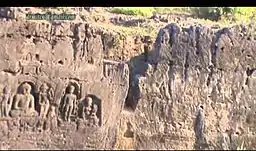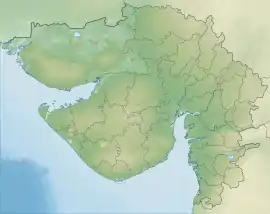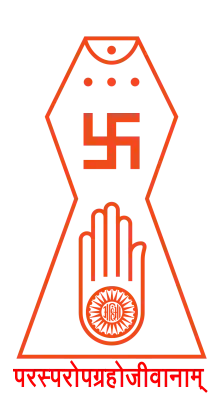Dhank Caves
The Dhank Caves are located near Dhank village near Upleta, Rajkot district, Gujarat, India. They were chiseled out of a calcareous sandstone outcropping during the regime of the Western Satraps. The caves are influenced by Buddhist and Jain cultures. The Buddhist cave include figures of Bodhisattva and the Jain cave includes figures of Adinath, Shantinath and Pārśva.[1] These are considered to be the earliest Jain sculptures in Kathiawad.
| Dhank Caves | |
|---|---|
 Jain Carving at Dhank Caves | |
 Location in Gujarat  Dhank Caves (Gujarat) | |
| Coordinates | 21.83°N 70.08°E |
| Part of a series on |
| Jainism |
|---|
 |
|
|
| Pilgrimage to |
| Buddha's Holy Sites |
|---|
 |
| The Four Main Sites |
| Four Additional Sites |
| Other Sites |
|
| Later Sites |
Details of Jain Carvings
This caves were carved in the 7th century A.D. and have a plain style of carving.[2]
This is one of the earliest rock cut cave of Gujarat. This place is also known as Dhankgiri and about 48 km of Junagadh in north west direction. on western side of the hill there are three niches. One niche is facing the door and another two are situated on either side of it.[3]
The door facing niche contains some Jain Images in kayotsarga and meditation posture. Most of Savior sculpture do not contain a clear cognizance or symbol of Tirthankara but according to H. D. Sanklia this image represents Rishabhnatha.[4] On either side of Jina two whisk bearers are depicted and Jina is sitting on a lion throne or Simhasan. There are two another mediation posture images of Tirthankara saviors containing two whisk bearers on either side with serenity and tranquility on face. Triple canopies were depicted over the head of Jina. One of these image is depicted with Deer cognizance attributed to 16th Lord Shantinatha.
One well preserved image of 23rd TIrthankara Parshvanatha is depicted in kayotsarga posture with long limbs parallel to body and cobra hood canopied. An image of Jaina yakshi ambika is also carved here who contains an infant in her arm and another with mango bud. from the ongoing discussion it is clearly evident that Dhank caves are attributed to Jainism and dwellers of these caves were Jain. Burgess did not say anything about the date of the Dhank caves but according to scholar H.D. Sanklia these caves could be hailed from 3rd Century AD after examining the Jaina sculpture's Style and Iconography. This cave is attributed to Digamabar Jain.[5]
There is second set of caves nearby known as Jhunjhurijhar caves having small rock cut rooms and baked bricks pillars.
References
- Archaeological Survey of India, Vadodara Circle. "Dhank Caves". Archaeological Survey of India. Archived from the original on 2 December 2013. Retrieved 1 December 2013.
- Fergusson, James; Burgess, James (6 May 2013). The cave temples of India. Cambridge: Cambridge University Press. pp. 186, 200–203. ISBN 978-1108055529.
- Unexplored Sites of Gujarat, India, Khushboo Gujarat Ki! Dhank jain and Buddhist caves (ढांक गाव की तीसरी सदी की प्राचीन जैन गुफा), retrieved 4 February 2019
- Sankalia, H. D. (1938). "The Earliest Jain Sculptures in Kāthiāwār". Journal of the Royal Asiatic Society of Great Britain and Ireland. 70 (3): 426–430. doi:10.1017/S0035869X00077844. JSTOR 25201741.
- Umakant Premanand Shah, Madhusudan A. Dhaky (1975). Aspect of Jaina art and architecture. Gujarat State Committee for the Celebration of 2500th Anniversary of Bhagavān Mahāvīra Nirvāna : distributors, L.D. Institute of Indology. pp. 77, 78.CS1 maint: uses authors parameter (link)
